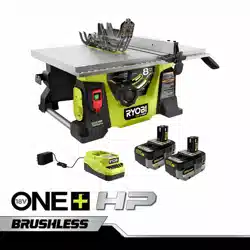Loading ...
Loading ...
Loading ...

22 - English
OPERATION
CAUSES OF KICKBACK
Kickback can occur when the blade stalls or binds, kicking
the workpiece back toward you with great force and speed. If
your hands are near the saw blade, they may be jerked loose
from the workpiece and may contact the blade. Obviously,
kickback can cause serious injury, and it is well worth using
precautions to avoid the risks.
Kickback can be caused by any action that pinches the
blade in the wood such as:
Making a cut with incorrect blade depth
Sawing into knots or nails in the workpiece
Twisting the wood while making a cut
Failing to support work
Forcing a cut
Cutting warped or wet lumber
Using the wrong blade for the type of cut
Not following correct operating procedures
Misusing the saw
Failing to use the anti-kickback pawls
Cutting with a dull, gummed-up, or improperly set blade
AVOIDING KICKBACK
Always use the correct blade depth setting. The top of
the blade teeth should clear the workpiece by 1/8 in. to
1/4 in.
Inspect the work for knots or nails before beginning a
cut. Knock out any loose knots with a hammer. Never
saw into a loose knot or nail.
Always use the rip fence when rip cutting. Use the miter
gauge when cross cutting. This helps prevent twisting
the wood in the cut.
Always use clean, sharp, and properly-set blades. Never
make cuts with dull blades.
To avoid pinching the blade, support the work properly
before beginning a cut.
When making a cut, use steady, even pressure. Never
force cuts. Do not release the workpiece until you have
pushed it completely past the blade.
Do not cut wet or warped lumber. The workpiece must
have a straight edge for it to be guided along the rip fence.
Use extra caution when cutting some prefinished or
composition wood products as the anti-kickback pawls
may not always be effective.
Always guide your workpiece with both hands or with
push sticks and/or push blocks. Keep your body in a
balanced position to be ready to resist kickback should
it occur. Never stand directly in line with the blade.
Use of a featherboard will help hold the workpiece securely
against the saw table or fence.
Clean the saw, blade guard, under the throat plate, and
any areas where sawdust or scrap workpieces may gather.
Keep blade guard, riving knife and ainti-kickback pawls
in place and proper operation. The riving knife must be
in alignment with the blade and the pawls must stop a
kickback once it has started. Check their operation before
ripping.
Maintain the rip fence parallel with the saw blade.
When ripping, apply the feed force to the section of the
workpiece between the blade and rip fence. Use a push
stick and/or push block when appropriate.
Use the right type of blade for the cut being made.
Always use the riving knife for every operation where it
is allowed. The use of this device will greatly reduce the
risk of kickback.
Loading ...
Loading ...
Loading ...
